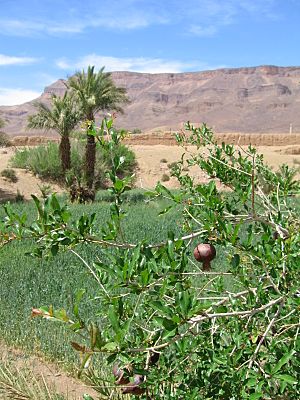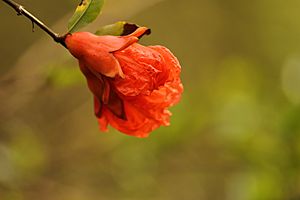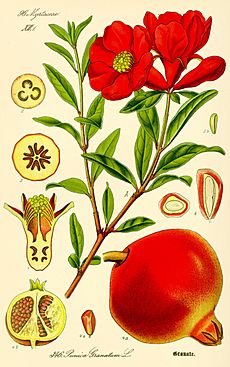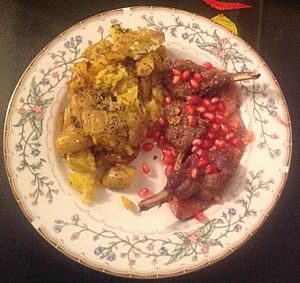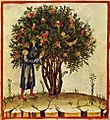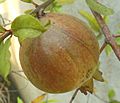Pomegranate facts for kids
Quick facts for kids Pomegranate |
|
|---|---|
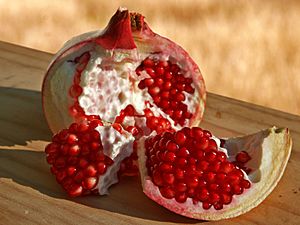 |
|
| Fruit of pomegranate | |
| Scientific classification | |
| Kingdom: | |
| Division: | |
| Class: | |
| Subclass: | |
| Order: | |
| Family: | |
| Genus: | |
| Binomial name | |
| Punica granatum |
|
The pomegranate (Punica granatum) is a special fruit. It has many seeds inside. These seeds are covered in a tasty red juice-filled part called the sarcotesta. In spring, the pomegranate tree shows off its beautiful, bright flowers.
Pomegranates first grew in Iran and the Himalayas in northern India. From there, they spread to many dry places that get rain only at certain times of the year. In Nepal, it's called anar, and in Sri Lanka, it's known as "delum".
Long ago, in ancient Rome, people crushed pomegranates to make a red dye. This color was special for very rich people or those in charge, like the Emperor. He often wore clothes dyed with pomegranate.
Other old cultures, like ancient Greece, also linked the pomegranate to the "underworld." The Greeks believed this fruit grew in the secret garden of Hades, who was the god of the underworld.
Contents
What a Pomegranate Looks Like
The pomegranate grows as a shrub or a small tree. It can reach about 5 to 10 meters (16 to 33 feet) tall. It has many spiky branches and can live for a very long time. Some pomegranate trees in France are over 200 years old!
The leaves of the pomegranate tree are shiny and narrow. They are about 3 to 7 centimeters (1 to 3 inches) long. The flowers are bright red and about 3 centimeters (1 inch) wide. They usually have three to seven petals. Some types of pomegranate trees are grown just for their pretty flowers, not for their fruit.
The Fruit, Arils, and Seeds
The pomegranate fruit has a tough, reddish-purple skin. Inside, there's a spongy white part that holds the seeds. These seeds are found in small, uneven sections. Each seed is covered in a juicy, thin red layer called an aril. This is the part we eat!
A single pomegranate can have anywhere from 200 to about 1,400 seeds.
From a plant scientist's point of view, the pomegranate fruit is a type of berry. It grows from one flower. The fruit is usually round and about 5 to 12 centimeters (2 to 5 inches) wide. It's somewhere between the size of a lemon and a grapefruit.
When the fruit is ripe, the juice from the arils and seeds can taste a bit sour. This is because it has a low pH and special plant compounds called polyphenols. These compounds can also make a red stain on clothes that is hard to remove! The red color of the juice comes from natural pigments called anthocyanins.
How Pomegranates Grow
People grow pomegranates for their delicious fruit. They are also grown as beautiful ornamental trees and shrubs in parks and gardens. Older trees can have cool, twisted trunks.
Pomegranates don't need a lot of water, so they can grow well in dry places. They can handle cold weather down to about -12°C (10°F). But in very wet areas, their roots can get sick from fungal diseases.
Some insects like the pomegranate butterfly and the leaf-footed bug can be pests. Fruit flies and ants are also attracted to ripe fruit that hasn't been picked.
Pomegranates can grow from seeds, but farmers usually grow them from cuttings. This means they take a piece of a healthy branch and plant it. This way, the new plant will be exactly like the parent plant.
Different Types of Pomegranates
There's a small type of pomegranate called P. granatum var. nana. It's a dwarf variety, meaning it stays small. People often plant it in gardens or in pots. It's also popular for bonsai trees, which are miniature trees.
The only other type of pomegranate in the same plant family is the Socotran pomegranate. This one only grows on the Socotra islands, which are part of Yemen. It has pink flowers instead of red ones, and its fruit is smaller and not as sweet.
Many Varieties
There are over 500 named types of P. granatum! But sometimes, the same type of pomegranate might have different names in different parts of the world.
Pomegranates can be different in many ways. Their size, the color of their skin (from yellow to purple, but pink and red are most common), and the color of their seeds (from white to red) can all vary. Some have hard seeds, while others have softer ones. The taste can also be different, from sweet to sour.
Pomegranate History and Culture
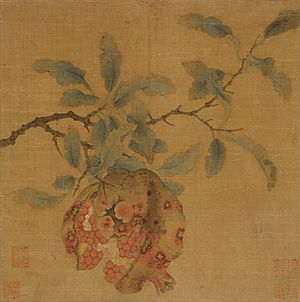
Pomegranates originally came from the area between modern-day Iran and northern India. For thousands of years, people have grown pomegranates across the Middle East, South Asia, and the Mediterranean region. They also grow well in the dry climates of California and Arizona today. Pomegranates might have been one of the first fruit trees that humans started to grow, as early as 5,000 BC.
Scientists have found burnt pieces of pomegranate skin from the Bronze Age in places like Tell es-Sultan (Jericho) and Cyprus. A large, dried pomegranate was even found in the tomb of an ancient Egyptian butler named Djehuty, who worked for Queen Hatshepsut. Old writings from Mesopotamia also mention pomegranates from about 2500 BC.
Pomegranate remains were found on a shipwreck from the 14th century BC off the coast of Turkey. Other valuable items like perfume, ivory, and gold jewelry were also on the ship. This suggests that pomegranates might have been seen as a luxury item back then.
Pomegranates are also widely grown in South China and Southeast Asia. They might have spread along the famous Silk Road trade route or by sea traders. Kandahar in Afghanistan is known for its excellent pomegranates.
Even though pomegranates are not native to Korea or Japan, they are very popular there. Many new types have been created. They are often used for bonsai trees because of their pretty flowers and the unique twisted bark they get as they age. The word "balaustine" is also used to describe a pomegranate-red color.
Spanish explorers later brought the fruit to the Caribbean and America. However, in the English colonies, it was harder for them to grow. An English botanist named Peter Collinson wrote to John Bartram in Philadelphia in 1762, telling him to plant pomegranates close to a house wall to help them grow. He said, "I have twenty-four on one tree... Doctor Fothergill says, of all trees this is most salutiferous to mankind." This means Doctor Fothergill thought pomegranates were very healthy for people.
Pomegranates had been brought to England earlier, but they didn't produce much fruit there. This led to many attempts to grow them in the American colonies, even in New England. They did well in the warmer Southern states. Thomas Jefferson planted pomegranates at his home, Monticello, in 1771.
Cooking with Pomegranates
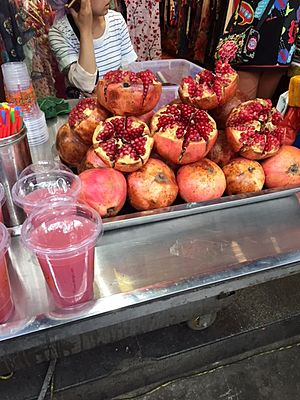

To open a pomegranate, you can score its skin with a knife and then break it apart. It's easiest to separate the seeds from the white pulp in a bowl of water, because the seeds will sink and the pulp will float. Freezing the whole fruit first can also make it easier. Another quick way is to cut the pomegranate in half, hold it over a bowl, and hit the back of the rind with a spoon. The seeds should pop right out!
Pomegranate juice can be sweet or sour. Most fruits have a balanced taste, with some sour notes from the natural acids. Pomegranate juice has been a popular drink in Europe and the Middle East for a long time. Now, you can find it in many places, including the United States and Canada.
Grenadine syrup used to be made from thick, sweet pomegranate juice. Today, it's often a mix of other berry flavors and food coloring, mostly used in cocktails. But in Europe, some companies still make grenadine with real pomegranate.
Before tomatoes came to the Middle East, pomegranate juice, molasses, and vinegar were used a lot in Iranian cooking. You can still find them in traditional recipes like fesenjān. This is a thick sauce made from pomegranate juice and ground walnuts, often served with duck or other poultry and rice. Another dish is ash-e anar, which is a pomegranate soup.
Pomegranate seeds are also used as a spice called anar dana (which means "pomegranate seed" in Persian). It's very popular in Indian and Pakistani cuisine. You can buy dried whole seeds in South Asian markets. They are dried for 10–15 days and used to add a sour taste to chutneys and curry dishes. Ground anardana is also used for a deeper flavor. Wild pomegranate seeds from the Himalayas are thought to be the best for this spice.
Dried pomegranate seeds, found in some health food stores, still have some moisture. This keeps their natural sweet and tart flavor. You can use them in trail mix, granola bars, or as a topping for salads, yogurt, or ice cream.
In the Caucasus region, pomegranates are mostly used for juice. In Azerbaijan, a sauce made from pomegranate juice called narsharab (meaning "pomegranate wine") is often served with fish or tika kabab.
In Turkey, pomegranate sauce (nar ekşisi) is used as a salad dressing, to marinate meat, or even just to drink. Pomegranate seeds are also added to salads and sometimes used to decorate desserts like güllaç. Pomegranate syrup is also used in muhammara, a spread made from roasted red pepper, walnuts, and garlic that is popular in Syria and Turkey.
In Greece, pomegranates are used in many recipes. These include kollivozoumi, a creamy soup with boiled wheat, pomegranates, and raisins. They are also in legume salads, Middle Eastern lamb kebabs with pomegranate glaze, and dips. Pomegranate is also made into a liqueur and a popular fruit confectionery used as an ice cream topping, mixed with yogurt, or spread like jam on toast.
In Mexico, pomegranates are often used to decorate the traditional dish chiles en nogada. The red seeds represent the red color of the Mexican flag in the dish.
Images for kids
-
A pomegranate tree in an illustration for the Tacuinum Sanitatis, made in Lombardy, late 14th century (Biblioteca Casanatense, Rome).
-
Pomegranate being trained as a bonsai
-
Girl with a Pomegranate, by William-Adolphe Bouguereau, 1875
-
Detail from Madonna of the Pomegranate by Sandro Botticelli, c. 1487 (Uffizi Gallery, Florence)
-
A pomegranate statue in Yerevan, Armenia
See also
 In Spanish: Granado para niños
In Spanish: Granado para niños



